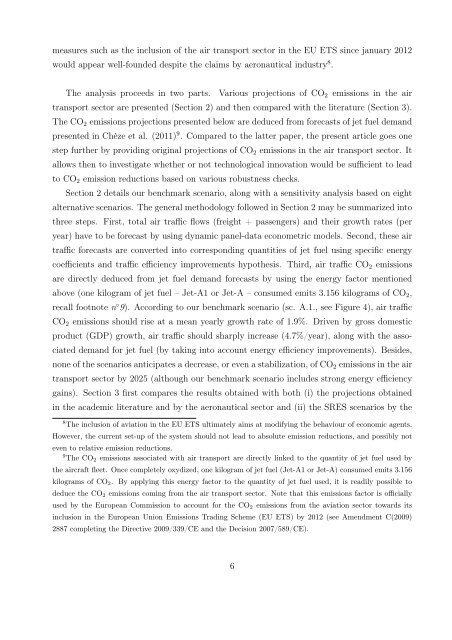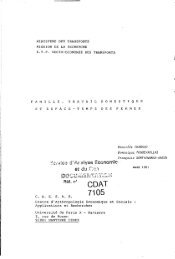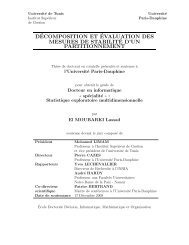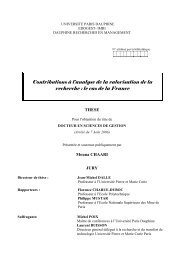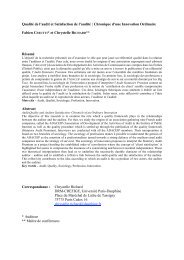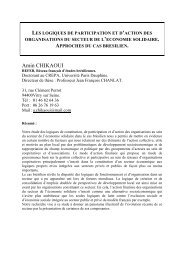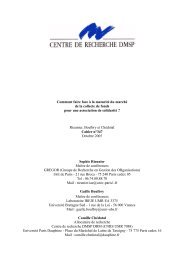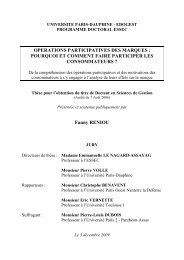12-02-Cahier-R- ... e-Chevallier-Gastineau.pdf - Base ...
12-02-Cahier-R- ... e-Chevallier-Gastineau.pdf - Base ...
12-02-Cahier-R- ... e-Chevallier-Gastineau.pdf - Base ...
You also want an ePaper? Increase the reach of your titles
YUMPU automatically turns print PDFs into web optimized ePapers that Google loves.
measures such as the inclusion of the air transport sector in the EU ETS since january 20<strong>12</strong><br />
would appear well-founded despite the claims by aeronautical industry 8 .<br />
The analysis proceeds in two parts. Various projections of CO2 emissions in the air<br />
transport sector are presented (Section 2) and then compared with the literature (Section 3).<br />
The CO2 emissions projections presented below are deduced from forecasts of jet fuel demand<br />
presented in Chèze et al. (2011) 9 . Compared to the latter paper, the present article goes one<br />
step further by providing original projections of CO2 emissions in the air transport sector. It<br />
allows then to investigate whether or not technological innovation would be sufficient to lead<br />
to CO2 emission reductions based on various robustness checks.<br />
Section 2 details our benchmark scenario, along with a sensitivity analysis based on eight<br />
alternative scenarios. The general methodology followed in Section 2 may be summarized into<br />
three steps. First, total air traffic flows (freight + passengers) and their growth rates (per<br />
year) have to be forecast by using dynamic panel-data econometric models. Second, these air<br />
traffic forecasts are converted into corresponding quantities of jet fuel using specific energy<br />
coefficients and traffic efficiency improvements hypothesis. Third, air traffic CO2 emissions<br />
are directly deduced from jet fuel demand forecasts by using the energy factor mentioned<br />
above (one kilogram of jet fuel – Jet-A1 or Jet-A – consumed emits 3.156 kilograms of CO2,<br />
recall footnote n ◦ 9). According to our benchmark scenario (sc. A.1., see Figure 4), air traffic<br />
CO2 emissions should rise at a mean yearly growth rate of 1.9%. Driven by gross domestic<br />
product (GDP) growth, air traffic should sharply increase (4.7%/year), along with the asso-<br />
ciated demand for jet fuel (by taking into account energy efficiency improvements). Besides,<br />
none of the scenarios anticipates a decrease, or even a stabilization, of CO2 emissions in the air<br />
transport sector by 2<strong>02</strong>5 (although our benchmark scenario includes strong energy efficiency<br />
gains). Section 3 first compares the results obtained with both (i) the projections obtained<br />
in the academic literature and by the aeronautical sector and (ii) the SRES scenarios by the<br />
8 The inclusion of aviation in the EU ETS ultimately aims at modifying the behaviour of economic agents.<br />
However, the current set-up of the system should not lead to absolute emission reductions, and possibly not<br />
even to relative emission reductions.<br />
9 The CO2 emissions associated with air transport are directly linked to the quantity of jet fuel used by<br />
the aircraft fleet. Once completely oxydized, one kilogram of jet fuel (Jet-A1 or Jet-A) consumed emits 3.156<br />
kilograms of CO2. By applying this energy factor to the quantity of jet fuel used, it is readily possible to<br />
deduce the CO2 emissions coming from the air transport sector. Note that this emissions factor is officially<br />
used by the European Commission to account for the CO2 emissions from the aviation sector towards its<br />
inclusion in the European Union Emissions Trading Scheme (EU ETS) by 20<strong>12</strong> (see Amendment C(2009)<br />
2887 completing the Directive 2009/339/CE and the Decision 2007/589/CE).<br />
6


